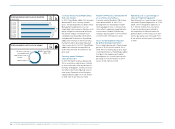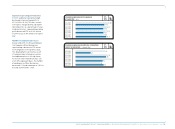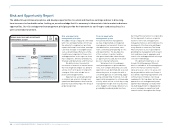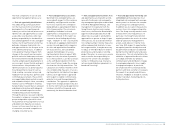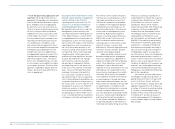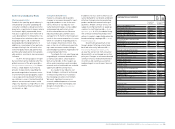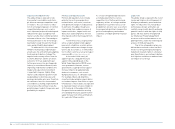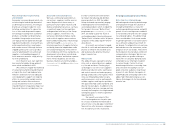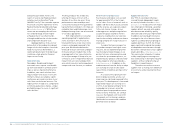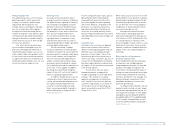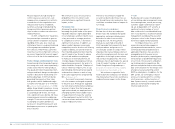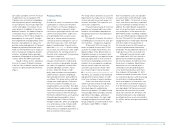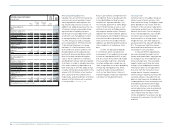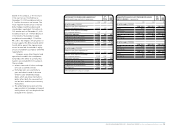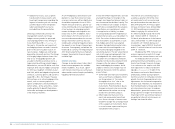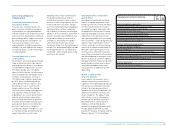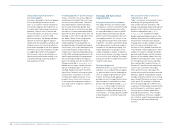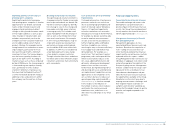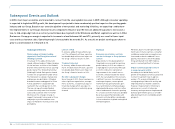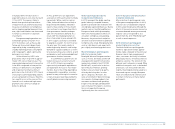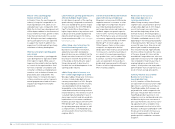Reebok 2009 Annual Report Download - page 152
Download and view the complete annual report
Please find page 152 of the 2009 Reebok annual report below. You can navigate through the pages in the report by either clicking on the pages listed below, or by using the keyword search tool below to find specific information within the annual report.
148 GROUP MANAGEMENT REPORT – FINANCIAL REVIEW Risk and Opportunity Report
We also regularly include change-of-
control clauses as well as non-cash
compensation components in contracts
to avoid the risk that negotiations are
reduced solely to price. In addition,
we follow a strategy of broadening the
Group’s portfolio of premium partner-
ships in order to reduce our reliance on
single affiliations.
In 2009, competition for top promo-
tion partnerships continued to grow as
several smaller competitors increased
spending in this area. As a result, we
still believe there is a medium likelihood
of losing important individual promo-
tion contracts. Nevertheless, given the
maturity of our most important contracts,
we assess the potential financial impact
of this risk to be low in the medium term.
Product design and development risks
Innovative and attractive products gener-
ate strong sales and – more importantly –
create a halo effect for other products.
The speed with which new product tech-
nologies and fresh designs are brought to
market is decisive for maintaining com-
petitive advantage. In 2009, all brands
generated the majority of their sales
with products which had been brought
to market over the past 12 to 18 months
see Research and Development, p. 92. If the
adidas Group failed to maintain a strong
pipeline of new innovative products over
a sustained period of time, we would
risk a significant sales decline. We focus
on pursuing our innovation and design
strength. To ensure we can quickly adapt
to changing consumer preferences,
we focus on streamlining research and
development processes to speed up the
time to market.
We continue to assess the occurrence
probability of this risk, which could
potentially have a significant financial
impact, as low.
Personnel risks
Achieving the adidas Group’s goal of
becoming the global leader in the sport-
ing goods industry is highly dependent
on our employees and their talents. Loss
of key personnel in strategic positions,
to competitors or others, is therefore a
significant risk we face. In addition, as
labour markets become increasingly
competitive, we also face the risk of being
unable to identify, recruit and retain the
most talented people that best meet the
specific needs of our Group. To reduce
this risk and enable our employees
to make use of their full potential, we
strongly engage in developing a motivat-
ing working environment. Our goal is to
make the adidas Group the “Employer of
Choice” within our industry. This is sup-
plemented by offering attractive reward
and incentive schemes as well as long-
term career opportunities and planning
see Employees, p. 97.
Our overall assessment of person-
nel risks remains unchanged compared
to the prior year. Although we expanded
our own-retail activities (where employee
turnover is higher than the Group aver-
age) and increased our employee base in
emerging markets (where higher levels
of wage inflation increase the volatility
of the employment market) in 2009, the
current economic environment is likely to
reduce employee turnover.
Therefore, we continue to regard the
occurrence likelihood of these risks as
low. Should these risks materialise, they
could have a medium financial impact on
our Group.
Risks from non-compliance
We face the risk that our employees
breach rules and standards that guide
appropriate and responsible business
behaviour. In order to successfully
manage this risk, the Group Policy
Manual was launched at the end of
2006 to provide the framework for basic
work procedures and processes. It
also includes a Code of Conduct which
stipulates that every employee shall act
ethically in compliance with the laws and
regulations of the legal systems where
they conduct Group business. All of our
employees have to participate in a special
Code of Conduct training as part of our
Global Compliance Programme see
Declaration on Corporate Governance including
the Corporate Governance Report, p. 33.
We continue to regard the likeli-
hood of grave misconduct as low. Should
they materialise, these risks could have a
medium financial impact on the Group.
IT risks
Key business processes including prod-
uct marketing, order management, ware-
house management, invoice processing,
customer support and financial report-
ing are all dependent on IT systems. A
significant systems outage or loss of
data could result in considerable disrup-
tions to our business. Insufficient project
management could delay the execution
of projects critical to the Group or make
them more expensive than planned.
To mitigate these risks, our IT
organisation proactively engages in
system preventive maintenance, service
continuity planning and adherence to
applicable IT policies. Data security is
managed by restricting user access
based on job description, requiring pass-
word changes at predefined frequencies
on our most critical systems and adher-
ing to data protection regulations. We
perform multiple backups at alternating
data centre locations for the Group’s core
enterprise resource planning system
(ERP) on a daily basis. In addition, for the
ERP system, our contingency solution
allows us to quickly switch to a remote
site if necessary – without any loss of
data. System security, controls and reli-
ability are reviewed and tested by the
Internal Audit function.


